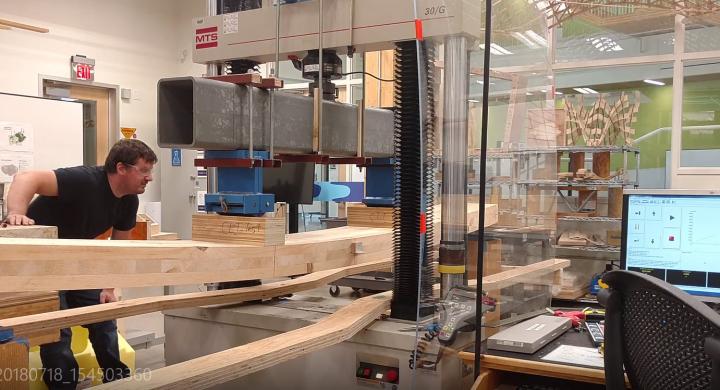Two NE tree species can be used in new sustainable building material

Panels of CLT were placed into a strength-testing machine at the UMass Wood Mechanics Lab, where a giant steel arm put thousands of pounds of pressure on the engineered wood until it broke. Credit: Peggi Clouston/UMass Amherst
Two tree species native to the Northeast have been found to be structurally sound for use in cross-laminated timber (CLT) – a revolutionary new type of building material with sought-after sustainability characteristics, according to research by a University of Massachusetts Amherst timber engineer.
The findings, published in the Journal of Materials in Civil Engineering, suggest that these trees – the eastern hemlock and eastern white pine – could support local markets for CLT.
The manufacturing of CLT, a type of mass timber used for wall, floor and roof construction, could create jobs, improve rural and forestry economies and support better forestry management, which is a strategy to address climate change, the research says.
“This is the future – prefabricated, panelized wood,” says lead author Peggi Clouston, professor of wood mechanics and timber engineering in the School of Earth and Sustainability.
“It's far more efficient and there's far less waste than site construction. It's less time- and labor-intensive than building with cast-in-place concrete” and has a much lower carbon footprint.
Clouston's leadership in state-of-the-art wood construction technology was instrumental in the creation of UMass Amherst's John W. Olver Design Building, a showcase for best practices in sustainability.
When the structure opened in 2017 to house academic departments and offices, it was considered the most technologically advanced CLT building in the country.
All the CLT for the Design Building was FSC-certified, ensuring it came from responsibly managed forests that deliver environmental, social and economic benefits.
“We wanted to show the world how to build a contemporary mass timber structure, and we are doing so. Groups have come from as far away as Taiwan to see it,” Clouston says.
Clouston and her team of researchers tested the eastern hemlock and eastern white pine in the UMass Wood Mechanics Lab at the Olver Design Building. They made the composite building panels by gluing together wooden boards from hemlock and pine trees that were grown in the region.
“We then broke them in a strength-testing machine to find out if they would be safe to use in a university-size building,” Clouston explains.
The researchers analyzed the results, comparing them to engineering requirements, and showed that both tree species met building standards, with eastern hemlock outperforming pine.
Salvaging wood from eastern hemlock is a key forest-management priority, Clouston explains, because the trees are under attack by an insect, the hemlock wooly adelgid. “The insect doesn't harm the wood, but it kills the tree, which in five to 10 years will rot and fall down, becoming hazardous fuel for forest fires,” she says.
Eastern hemlock also is considered low-value because it's prone to a wood defect called ring shake and isn't used in structural framing. “Turning this particular species into CLT turns a very low-value material into a very high-value building product,” Clouston says.
Identifying low-carbon materials for construction is an emerging buzz among architects, and the timing is right to encourage CLT production in the Northeast, the research concludes.
“The testing we did shows that anyone who would want to invest in a local plant has a reason to do so,” says Clouston, whose trailblazing work was recently highlighted in a Washington Post feature story. “The prospect of being able to use local wood in CLT and manufacture it locally makes it all the more sustainable by avoiding the environmental cost of transporting the material long distances.”
Media Contact
All latest news from the category: Architecture and Construction
Newest articles

Superradiant atoms could push the boundaries of how precisely time can be measured
Superradiant atoms can help us measure time more precisely than ever. In a new study, researchers from the University of Copenhagen present a new method for measuring the time interval,…

Ion thermoelectric conversion devices for near room temperature
The electrode sheet of the thermoelectric device consists of ionic hydrogel, which is sandwiched between the electrodes to form, and the Prussian blue on the electrode undergoes a redox reaction…

Zap Energy achieves 37-million-degree temperatures in a compact device
New publication reports record electron temperatures for a small-scale, sheared-flow-stabilized Z-pinch fusion device. In the nine decades since humans first produced fusion reactions, only a few fusion technologies have demonstrated…





















